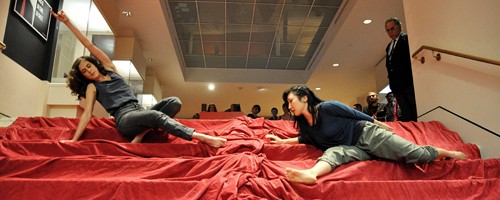“This is beautiful,” remarked Portland State student Briana Romancier as she gazed at “The Violoncellist,” a painting by Gustave Courbert, in the Portland Art Museum. “It makes me want to go back to the dorm and just start creating something, anything. It’s actually really inspiring.”
It’s moments like these that the museum strives for, which is why it collaborated with Portland State’s Masters of Fine Arts program Friday to host the third annual “Shine a Light” event.
This collaborative event crafts programs, performances and interventions, all with the goal of expanding the ways people use the art museum, according to press material. On Oct. 14, the university’s MFA students took over the museum from 10 a.m. to midnight, showcasing their art and creating an oppurtunity to rethink the museum’s possibililties.
“Shine a Light” was created by Director of Education and Public Programs Christina Olsen and Harrell Fletcher and Jen Delos Reyes, Co-Directors of the Social Practice program at PSU, to broaden the ways in which people are involved with the museum.
“I would like the public to come to the realization that a lot of different things can happen in a museum,” Reyes said. “It is not only a place of reverence for artwork; it can be activated in so many other ways.”
In the MFA program, “students work in a non-studio capacity and their work is not studio-oriented but comes out of the context of the environment that they are in,” Reyes said.
There are 19 graduate students involved with MFA this year, and they, along with undergraduates involved in the program, chose a project that both relates to the community and to artwork in the museum.
The morning kicked off at 10 a.m. with projects such as “Museum Cookbook” by Lexa Walsh and Crystal Baxley, in which the artists collaborated with local chefs to publish recipes inspired by museum artwork. There was also the QR/ART created by Krystal South, which elicited artists’ around-the-world smartphone responses to pieces found in the Portland Art Museum.
“This was posed as a response to the lack of new media artwork in the collection of the art museum,” South said. “These artists have provided their post-Internet perspective to works of a very diverse nature.”
One of the most popular activities was “Art Is Forever” by Jason Sturgill, in which Portland artists created illustrations inspired by the museum that were then tattooed on museumgoers by volunteer artists from Portland, free of charge. This event ran on a first come, first served basis, and all spots were taken before the first hour was up.
“I wanted people to come to the event and receive a deeper connection to the museum,” Sturgill said. “You can come to the museum and make it your own. It’s all about the interconnectedness.”
It was not until 6 p.m., however, that “Shine a Light 2011” really came alive. The evening activities ranged from drinking beer and conversing with a complete stranger to poetry sessions, square dancing, break dancing, extended tours and ballet.
All 29 projects were designed to stir the audience.
“The moment that was most powerful for me happened when I went to do one of the non-visual museum tours. You would close your eyes and were guided throughout the museum to simulate the experience of being blind,” Olsen recalled. “It was extremely moving to me. I found I paid attention to the things in the museum that I would have otherwise never paid attention to. It really broadens how you experience the museum.”
At the end of the day, Reyes hoped that the 2,400 people in attendance left with a new sense of what the museum experience should mean. She believes that through projects such as “Shine a Light 2011”, the Portland Art Museum connects to many different communities that wouldn’t normally visit the museum.
“The culture of museums needs to change in general. They need to make efforts to connect with a wide variety of people,” Reyes said. “Art should be for everyone. The museum should be for everyone.”

